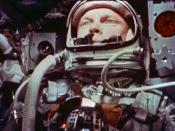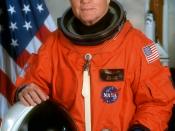John Glenn
In July 1957, while project officer of the F8U Crusader, he set a transcontinental speed record from Los Angeles to New York, spanning the country in 3 hours and 23 minutes. This was the first transcontinental flight to average supersonic speed. Glenn has nearly 9,000 hours of flying time, with approximately 3,000 hours in jet aircraft.
NASA EXPERIENCE: Glenn was assigned to the NASA Space Task Group at Langley Research Center, Hampton, Virginia, in April 1959 after his selection as a Project Mercury Astronaut. The Space Task Group was moved to Houston and became part of the NASA Manned Spacecraft Center in 1962. Glenn flew on Mercury-6 (February 20, 1962) and STS-95 (October 29 to November 7, 1998), and has logged over 218 hours in space. Prior to his first flight, Glenn had served as backup pilot for Astronauts Shepard and Grissom. When astronauts were given special assignments to ensure pilot input into the design and development of spacecraft, Glenn specialized in cockpit layout and control functioning, including some of the early designs for the Apollo Project.
Glenn resigned from the Manned Spacecraft Center on January 16, 1964. He was promoted to the rank of Colonel in October 1964 and retired from the Marine Corps on January 1, 1965. He was a business executive from 1965 until his election to the United States Senate in November 1974. Glenn retired from the U.S. Senate in January 1999.
SPACE FLIGHT EXPERIENCE: On February 20, 1962, Glenn piloted the Mercury-Atlas 6 "Friendship 7" spacecraft on the first manned orbital mission of the United States. Launched from Kennedy Space Center, Florida, he completed a successful three-orbit mission around the earth, reaching a maximum altitude (apogee) of approximately 162 statute miles and an orbital velocity of approximately 17,500 miles per hour. Glenn's "Friendship...


